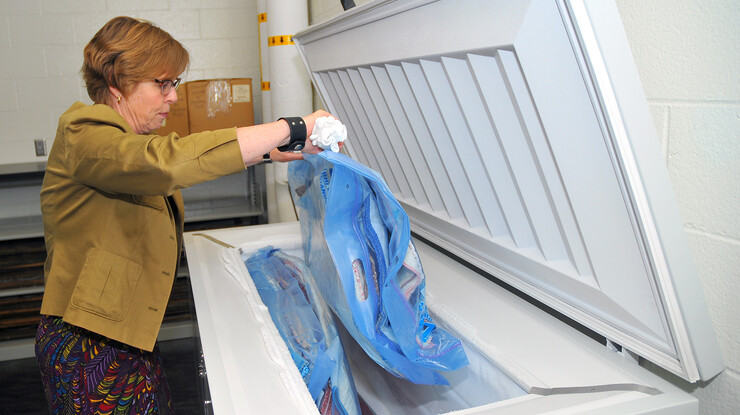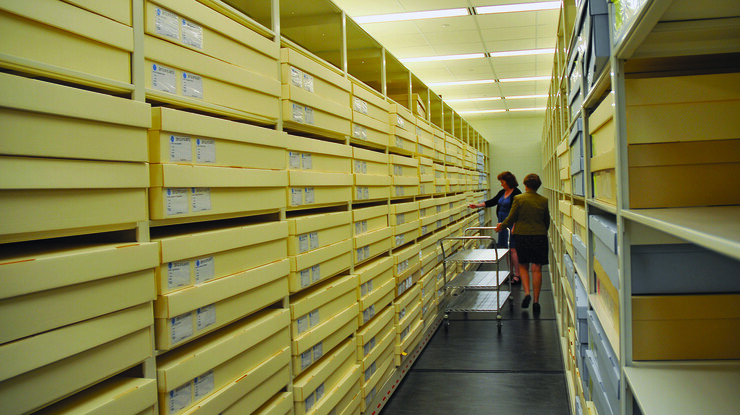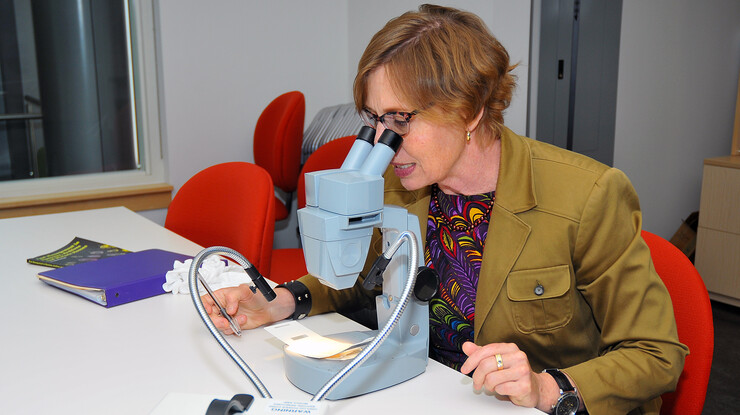· 4 min read
Museum uses hands-on approach to protect quilts

Quilt protection at the International Quilt Study Center and Museum is extremely cool.
Forty below zero actually — cold enough to burn exposed human skin and eliminate fabric-munching creepy crawlies.
Rather than storing the museum’s 4,500-plus quilts in cedar-lined chests, a team led by Kim Taylor uses a special freezer as the museum’s front line defender against insects.
“The first thing we do with all quilts, whether they are new or returning to the collection after being on display outside the museum, is put them in the freezer in isolation,” said Taylor, a collections manager for the museum. “The temperature drops quickly, killing any bugs or larvae before they can infest the rest of our collection.”
Assisted by a team of volunteers, Taylor works as the museum’s lead defender of the quilts. Along with giving the quilts an initial cold shoulder, Taylor’s duties include registering quilts new to the collection, maintaining the museum’s digital database, overseeing regular refolding of stored quilts, checking sticky bug traps in the museum, and contacting campus exterminators (if necessary).
To minimize any transfer of pests, new and returning quilts are kept in isolation in a room separate from the museum’s collection storage area. When quilts exit the freezer, they are stored in sealed plastic bags for two weeks. Workers check the bags for signs of insects during the isolation period. If evidence of insects appears in the bag, the offending quilt is transferred back to the freezer.
“We are very serious about keeping unwanted guests out of the collection,” said Carolyn Ducey, curator of collections for the museum. “We follow all policies of the American Alliance for Museums. People may think we’re strict, but everything we do is to protect the quilts. They are important pieces of art and each has a story to tell.”
When a quilt is added to the collection, a cloth label with basic information and a unique database number. All information gathered during the initial assessment — including photographs — is recorded and entered into the museum’s digital quilt database.
Storage depends on how to best protect the quilt. Most are loosely folded, wrapped in tissue paper and placed in archival boxes. Others are stored flat in drawers or rolled around a foam pipe.
“We have a number of studio art quilts that include painted surfaces,” Ducey said. “They cannot be folded, so we use rolled storage.”
Humidity and temperature are regulated in the storage room to further protect the quilts. To keep permanent creases from forming, each stored quilt is brought out for vacuuming, assessment and refolding every two years. Museum volunteers — many of whom are quilters — do the work.
“Our volunteers are trained to work in teams,” Ducey said. “The Monday crew just refold and assesses the quilts. Our Thursday teams vacuum, assess and refold.
“The vacuuming is actually fairly important as it removes any dust, which has sharp edges and can do damage if left on the quilt. And the assessment is important as it helps us track any deterioration.”
The same cleaning, assessment and folding process is completed on quilts returning from displays in the IQSCM or in other museums, and for items pulled for research purposes.
The museum’s final defense against critter attacks is much more hands-on for Taylor.
“Once a month, I go around the museum gathering all these sticky bug traps and see what we’ve caught,” Taylor said. “I write down the kinds of insects we find and in what numbers.”
If problem insects are found — primarily silverfish, carpet beetles and wool moths — Taylor contacts a campus exterminator who responds immediately.
“We’ve only had to call a couple of times,” Taylor said. “Our system to protect the quilts is very efficient.”
And, it turns out the system is better than traditional cedar.
“Cedar chests are great at keeping insects out,” Ducey said. “But, they are very risky because if the cedar is not completely dry, oils from the wood will be pulled out and stain cotton textiles.
“You’ll never see one of our quilts touch wood for that very same reason.”
For more information about the International Quilt Study Center and Museum, go to http://www.quiltstudy.org.










